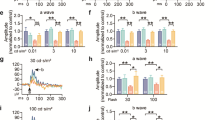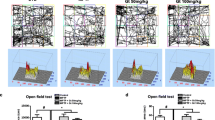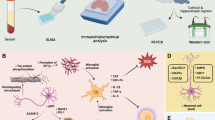Abstract
Neurofibrillary tangles (NFTs) are the major component of senile plaques in the brains of patients with Alzheimer's disease (AD). However, the mechanism causing NFTs accumulation in AD patients’ retina is also elusive. Thus, we investigated the effects of ginsenoside Rg1 on NFTs accumulation in retinal pigment epithelial (RPE) cells isolated form double transgenic APP/PS1 mice model. NFTs amounts in culture supernatants were examined by enzyme-linked immunosorbent assay. Activity and mRNA transcription of enzymes and proteins that regulate NFTs accumulation were examined by activity assay and reverse transcription PCR. The expression of neprilysin (NEP) and neutral endopeptidase (PKA) were detected by western blot assay. Rg1 significantly decreased NFTs accumulation in isolated RPE cells. Activity of NEP was significantly increased, and activity of PKA was significantly decreased in cell lysates of Rg1-feeding APP/PS1 mice compared with non-Rg1-feeding mice. mRNA level of NEP was significantly higher and mRNA level of PKA was significantly lower in cells of Rg1-feeding mice than nonfeeding mice. The phosphorylation of tau at Thr231, Thr205, and Ser396 were significantly decreased in RPE of Rg1-feeding APP/PS1 mice compared with the non-Rg1-feeding mice. Rg1 decreased the NFTs production in RPE cell of APP/PS1 mice by modulating the expression and activity of NEP and PKA, which perform the function through downregulating the phosphorylation of tau protein.




Similar content being viewed by others
References
Chen LM, Li ZY, Zhu YG, Lin N, Zhang J, Pan XD, Chen XC (2012) Ginsenoside Rg1 attenuates β-amyloid generation via suppressing PPAR-regulated BACE1 activity in N2a-APP695 cells. Eur J Pharmacol 675(1–3):15–21
Devi L, Ohno M (2010) Genetic reductions of beta-site amyloid precursor protein-cleaving enzyme 1 and amyloid-beta ameliorate impairment of conditioned taste aversion memory in 5XFAD Alzheimer's disease model mice. Eur J Neurosci 31(1):110–118
Frost S, Martins RN, Kanagasingam Y (2010) Ocular biomarkers for early detection of Alzheimer's disease. J Alzheimers Dis 22(1):1–16
Giaccone G, Orsi L, Cupidi C, Tagliavini F (2011) Lipofuscin hypothesis of Alzheimer's disease. Dement Geriatr Cogn Disord 1(1):292–296
Huang TW, Fang F, Chen LM, Zhu YG, Zhang J, Chen XC, Yan SS (2012) Ginsenoside Rg1 attenuates oligomeric Aβ1-42 induced mitochondrial dysfunction. Curr Alzheimer Res 9(3):388–395
Klein RL, Lin WL, Dickson DW, Lewis J, Hutton M, Duff K, Meyer EM, Kiing MA (2004) Rapid neurofibrillary tangle fromation after localized gene transfer for mutated tau. Am J Pathol 164(1):347–353
Kril JJ, Patel S, Harding J, Halliday GM (2012) Neuron loss from the hippocampus of Alzheimer's disease exceeds extracellular neurofibrillary tangle formation. Acta Neuropathol 103:370–376
Lai MKP, Chen CP, Hope T (2010) Hippocampal neurofibillary tangle changes and aggressive behaviour in dementia. Neuroreport 21:1111–1115
Lee HG, Perry G, Moreira PI, Garrett MR, Liu Q, Zhu X, Takeda A, Nunomura A, Smith MA (2005) Tau phoshporylation in Alzheimer's disease: pathogen or protector? Trends Mol Med 11(4):164–169
Li X, Liu Y, Zhang X, Yuan H, Quan Q (2010) Effect of ginsenoside Rg1 on expression of phosphory protein tau and N-methyl-d-aspartate receptor subunits NR1 and NR2B in rat brain slice model of Alzheimer's disease. Zhongguo Zhong Yao Za Zhi 35(24):3339–3343
Luan K, Rosales JL, Lee KY (2013) Viewpoint stalks between neurofibrillary tangles and amyloid plaque fromation. Ageing Res Rev 12(2):174–181
Mandelkow EM, Mandelkow E (2012) Biochemistry and cell biology of tau protein in neurofibrillary degeneration. Cold Spring Harb Perspect Med 2(7):a006247
Matsumura K, Ono M, Yoshimura M, Kimura H, Watanabe H, Okamoto Y, Ihara M, Takahashi R, Saji H (2013) Synthesis and biological evaluation of novel styryl benzimidazole derivatives as probes for imaging of neurofibrillary tangles in Alzheimer's disease. Bioorg Med Chem 21(11):3356–3362
Ohno-Matsui K (2011) Parallel findings in age-related macular degeneration and Alzheimer's disease. Prog Retin Eye Res 30(4):217–238
Shi C, Na N, Zhu X, Xi J (2013) Estrogenic effect of ginsenoside Rg1 on APP processing in post-menopausal platelets. Platelets 24(1):51–62
Sivak JM (2013) The aging eye: common degenerative mechanisms between the Alzheimer's brain and retinal disease. Investig Ophthalmol Vis Sci 54(1):871–880
Song XY, Hu JF, Zhang Z, Xu S, Yuan YH, Han N, Liu Y, Niu F, He X, Chen NH (2013) Ginsenoside Rg1 attenuates okadaic acid induced spatial memory impairment by the GSK3β/tau signaling pathway and the Aβ formation prevention in rats. Eur J Pharmacol 710(1–3):29–38
Vom Berg J, Prokop S, Miller KR, Obst J, Kalin RE, Lopategui-Cabezas I, Wegner A, Mair F, Schipke CG, Peters O, Winter Y, Becher B, Heppner FL (2012) Inhibition of IL-12/IL-23 signaling reduces Alzheimer's disease-like pathology and cognitive decline. Nat Med 18:1812–1819
Wang JY, Ohno-Matsui O, Morita I (2012) Cholesterol enhances amyloid β deposition in mouse retina by modulating the activities of Aβ-regulating enzymes in retinal pigment epithelial cells. Biochem Bioph Res Commun 424(4):704–709
Williams PA, Thirgood RA, Oliphant H, Frizzati A, Littlewood E, Votruba M, Good MA, Williams J, Morgan JE (2013) Retinal ganglion cells dendritic degeneration in a mouse model of Alzheimer's disease. Neurobiol Aging 34(7):1799–1806
Zhang X, Wang J, Xing Y, Gong L, Li H, Wu Z, Li Y, Wang J, Wang Y, Dong L, Li S (2012) Effects of ginsenoside Rg1 or 178-β-estradiol on a cognitively impaired, ovariectomized rat model of Alzheimer's disease. Neuroscience 220(1):191–200
Conflicts of interest/disclosures
The authors declare that they have no financial or other conflicts of interest in relation to this research and its publication.
Author information
Authors and Affiliations
Corresponding author
Rights and permissions
About this article
Cite this article
He, Y., Zhao, H. & Su, G. Ginsenoside Rg1 Decreases Neurofibrillary Tangles Accumulation in Retina by Regulating Activities of Neprilysin and PKA in Retinal Cells of AD Mice Model. J Mol Neurosci 52, 101–106 (2014). https://doi.org/10.1007/s12031-013-0173-7
Received:
Accepted:
Published:
Issue Date:
DOI: https://doi.org/10.1007/s12031-013-0173-7




